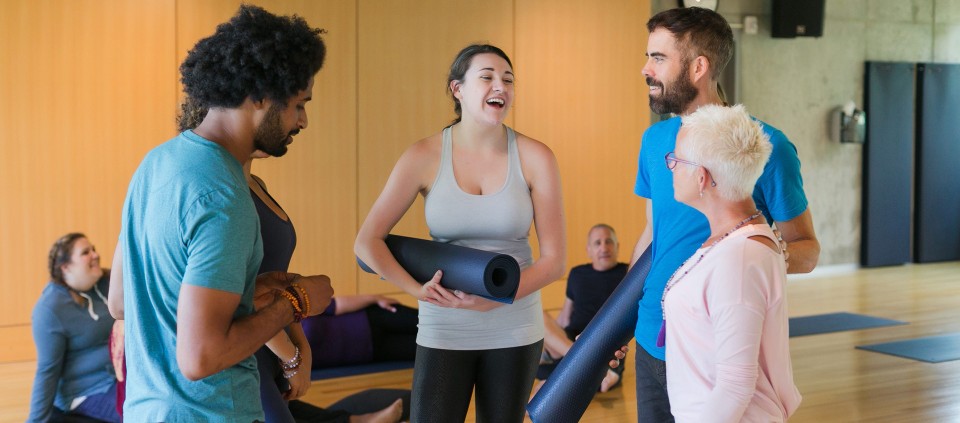Five Tips for Growing Your Yoga Classes

Being a yoga teacher is not an easy way to earn a living. To establish a consistent and sustainable business is challenging. Many of us begin teaching because we love yoga, and yoga has profoundly changed our life in some way. What we don’t always realize is that, when we’re teaching yoga as a career, we are also running our own business.
After 15 years of owning a yoga studio and sussing out the factors that have the greatest impact on class attendance, I’ve learned that there are many reasons why some yoga classes attract more students than others. If a class is doing well, it could mean that the timing is convenient for more people, the class type or level appeals to a wide number of students, and/or the studio (and teacher) does a good job marketing and promoting its offerings.
However, what ultimately matters most is what the teacher does within the classroom and beyond. With that in mind, here are my top five tips for expanding and retaining your student base.
1. Share your “why.”
As a yoga teacher, you are someone who students look to for wisdom and guidance, whether on learning how to feel better in their bodies, gain self-confidence, live in a more healthy and mindful way, or experience a deeper sense of connection. People come to yoga for all sorts of reasons, and there’s also a reason why they’re drawn to certain teachers over others. One of my favorite yoga teachers, Chrissy Carter, reminded me once, “If you teach from your heart, you will attract the right students—your students.” Your students will want to learn from you because they resonate with your story and the lessons you have to offer as a result of your unique journey.
Therefore, reflect on your story—where you were before yoga, what yoga has brought to your life, how you incorporate these practices into your daily routine—and then own that story by sharing it in an enthusiastic, authentic, and passionate way. Being transparent and genuine about the fact that you are also on this journey of life and learning, just like everyone else. Honoring your “why” also reminds you of your love for yoga and the reasons you became a teacher in the first place—especially helpful on those days when you feel burnt out or uninspired.
2. Find your “wow.”
Think about what you are good at, what you are ridiculously passionate about, and link those with what your students (and the world) need. Craft your offerings with these things in mind. A teacher will always deliver a memorable and transformative experience when they are sharing what they are good at and what they love to teach. To stand out in today’s oversaturated yoga market, your “wow,” coupled with your “why,” will help you create unique, transformative offerings for your students.
3. Focus on community.
When you create a sense of belonging with your students, they will keep coming back. They will develop a connection not only with you, but also with other students and with the larger experience of being part of your vibrant yoga community, or sangha. It comes down to your ability to hold space, and to help others feel seen, heard, and valued. Learning the names, goals, and challenges of your students is essential. Give them individual attention as much as possible: Call them by name, remember their birthdays, notice how they’re doing, learn more about them. Plan community events or get-togethers for the group. Start a book club. Always let your students know how thankful you are that they have shown up, and when your classes are small, focus on those that did come, not those who didn’t.
4. Shift your social media mindset.
Many yoga teachers feel awkward about promoting themselves on social media, but for most of us, this is an integral step in growing your yoga business. In order to create a sustainable career, yoga teachers need to market their services. One way to feel more comfortable in this space is to reframe social media: Think of it as a continuation of your classroom experience, a forum in which to extend your reach off the mat. Use your posts to disseminate teaching, practices, and inspiration, not just to promote your classes and offerings. Social media allows you to share your “why” and your “wow” with a wider audience, ultimately supporting you to help more people and make a larger impact in the world.
5. Be a continuous student. Yoga is a lifelong journey of learning. Remember that you will never know it all, so don’t act like you do. Keep learning—from your fellow teachers, in advanced trainings, and from your students. Read, study, retreat, maintain a personal practice, and apply what you learn to your own life and teaching. Self-care and regular practice will boost you up on those days when you feel less than inspired. If you’re not doing your own practice—both on and off the mat—I guarantee that your students will feel it.
Growing your classes is a process, and is propelled by consistency. Look for trends over time; don’t get down on yourself if your class size fluctuates a bit, but do track attendance so that you get a clear picture.
Most importantly, if you continue to teach from the heart, you can’t go wrong.
Liza Bertini, E-RYT 500, a personal development coach, yoga and mindfulness educator, and leadership trainer, is the Former Dean of the Kripalu School of Yoga.
Full Bio and Programs
